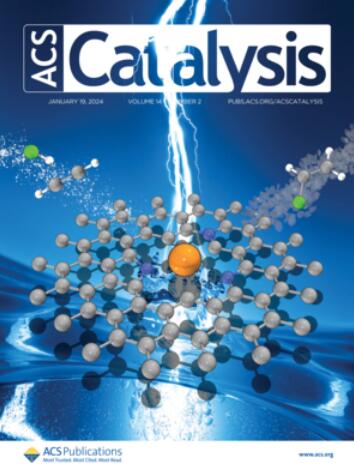In3+-Induced In–O–Sn Superexchange and Oxygen Vacancies Synergistically Boosting Acidic CO2‑to-HCOOH Electrolysis at Ampere-Current Levels over Sn-Based Perovskite Oxides
IF 13.1
1区 化学
Q1 CHEMISTRY, PHYSICAL
引用次数: 0
Abstract
Sn-based catalysts feature significant potential for acidic CO2 electroreduction (CO2RR) to HCOOH, but encounter unsatisfactory selectivity and poor stability, especially at high current densities. Here, we report In3+-induced In–O–Sn superexchange and oxygen vacancies synergistically enabling ampere-level, selective, and stable CO2-to-HCOOH electroreduction over Sn-based perovskite oxides in a strong acid. For the proof-of-concept catalysts of SrSn1–In3+诱导的In-O-Sn超交换和氧空位协同促进sn基钙钛矿氧化物在安培电流水平下的酸性CO2 - to-HCOOH电解
锡基催化剂具有显著的酸性CO2电还原(CO2RR)制氢cooh的潜力,但选择性不理想,稳定性差,特别是在高电流密度下。在这里,我们报道了In3+诱导的in - o- sn超交换和氧空位协同作用,使在强酸中sn基钙钛矿氧化物上实现了安培级、选择性和稳定的co2到hcooh的电还原。对于SrSn1-x In x O3−δ (x = 0.05, 0.1和0.2)的概念验证催化剂,In3+的引入不仅产生了额外的氧空位,而且产生了明显的In -o - sn超交换。这种超交换调节了电子结构,包括向上移动的能带中心(例如,sn5p)和加强的Sn - o键共价。在HCOOH生产中,相对于亲本SrSnO3, SrSn1-x In x O3−δ系列表现出活性和选择性的增强(随着In3+含量的增加而更加明显),同时也具有显著提高的稳定性。在强酸(pH = 1)条件下,SrSn0.8In0.2O3−δ在1 A cm-2条件下的HCOOH选择性高达91.2%,单次碳效率高达81.0%,且稳定运行80 h以上,优于以往报道的sn基催化剂。我们的实验和理论计算将这些性能的提高归因于以下因素:超交换移位的能带中心和额外的氧空位协同促进了*CO2质子化到*OCHO;超交换强化的Sn-O键共价稳定了Sn-O晶格。
本文章由计算机程序翻译,如有差异,请以英文原文为准。
求助全文
约1分钟内获得全文
求助全文
来源期刊

ACS Catalysis
CHEMISTRY, PHYSICAL-
CiteScore
20.80
自引率
6.20%
发文量
1253
审稿时长
1.5 months
期刊介绍:
ACS Catalysis is an esteemed journal that publishes original research in the fields of heterogeneous catalysis, molecular catalysis, and biocatalysis. It offers broad coverage across diverse areas such as life sciences, organometallics and synthesis, photochemistry and electrochemistry, drug discovery and synthesis, materials science, environmental protection, polymer discovery and synthesis, and energy and fuels.
The scope of the journal is to showcase innovative work in various aspects of catalysis. This includes new reactions and novel synthetic approaches utilizing known catalysts, the discovery or modification of new catalysts, elucidation of catalytic mechanisms through cutting-edge investigations, practical enhancements of existing processes, as well as conceptual advances in the field. Contributions to ACS Catalysis can encompass both experimental and theoretical research focused on catalytic molecules, macromolecules, and materials that exhibit catalytic turnover.
 求助内容:
求助内容: 应助结果提醒方式:
应助结果提醒方式:


